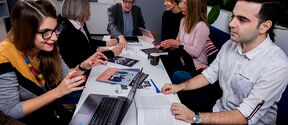The Suomi 100 satellite will be a milestone in Finland’s space history
Artist’s impression of the Suomi 100 satellite orbiting the Earth. The experimental 3D printed plastic part is clearly visible in the forward section of the satellite. The antennae for the radio research device are contained inside it. The camera lens can be seen in the centre of the plastic part. Photo: Aalto University
At the end of October, the Government submitted our country’s first Space Act for approval to accelerate the launches of the Aalto-1 and Aalto-2 satellites. The Act, which is progressive by international standards too, takes into account Finland’s growing space activities and it covers nanosatellites such as Aalto-1 and Aalto-2 as well as the Suomi 100 satellite that was originally planned for launch at the end of the year.
The Act has not yet been passed, but it is being observed with respect to the Suomi 100 satellite. Although the satellite will be delivered to the launch company based in the Netherlands, it will eventually end up outside Europe and leave the earth. According to the Act, this means that before it is handed over for launching, the satellite must have a separate export permit which was not required for previous satellites. The Suomi 100 satellite that is waiting at Aalto University, ready to go, must also be subject to a detailed risk analysis.
The Suomi 100 satellite’s journey into space is being delayed, not by the new Act, but by the investigation into the fault that occurred in the August flight of the Indian PSLV rocket that will be used for the launch and which has delayed the launch schedule.
‘Satellite launch schedules always depend on many different factors. The original flight planned for the Suomi 100 satellite has been moved to March of next year’, explains Professor Esa Kallio of Aalto University who is the director responsible for the satellite project.
The satellite was to have had a place on an earlier flight that is now scheduled for December. However, further investigations of the failure of the PSLV rocket as well as and Finnish permit issues will shift of the starting of the Suomi 100 satellite’s journey to space to 2018.
In space, the Suomi 100 satellite will examine space weather using a special radio measuring device and will also use its camera to take pictures of the Earth, inner space phenomena and of Finland. The other organisation responsible for the project, the Finnish Meteorological Institute, is taking care of the satellite’s computer software. The Institute has a lot of experience in the manufacture of space research devices. The satellite will also test a 3D printed plastic structure, that was developed by Aalto University, in space for the first time.
The Suomi 100 satellite’s space exhibitions will open on 21 November
Even though the launch of the Suomi 100 satellite has been delayed, the “Truck satellite”, built by the visitors to the Space Truck that toured Finland during September and October, will be departing on its own journey, weather permitting, on 21 November. The device, which has the same functions as the real satellite, will be lifted by balloon to a height of about 30 kilometres and during its journey, estimated at about three hours, it will send information to Aalto University’s satellite ground station. The journey was planned immediately at the end of the Space Truck’s trip, but unfavourable weather conditions prevented the balloon from flying.
The Space Truck exhibition will open on the same day at the WeeGee Exhibition Centre in Espoo. The exhibition will be open until April next year, and will not only have information about the Suomi 100 satellite, but also about Finnish satellites and space research more generally.
Further information:
Professor Esa Kallio, Aalto University
tel. +358 50 420 5857
esa.kallio@aalto.fi
Head of Research Unit, Ari-Matti Harri, Finnish Meteorological Institute
tel. +358 50 337 5623
ari-matti.harri@fmi.fi
Satellite mission’s web pages: http://suomi100satelliitti.fi/
Read more news

Research Council of Finland establishes a Center of Excellence in Quantum Materials
The Centre, called QMAT, creates new materials to power the quantum technology of coming decades.
Major funding powers development of next-generation machine technology aimed at productivity leap in export sectors
The BEST research project is developing new types of sealing, bearing, and damping technology.
The TAIMI project builds an equal working life – a six-year consortium project seeks solutions to recruitment and skill challenges
Artificial intelligence (AI) is changing skill requirements, the population is aging, and the labor shortage is deepening. Meanwhile, the potential of international experts often remains unused in Finland. These challenges in working life are addressed by the six-year TAIMI project funded by the Strategic Research Council, and implemented by a broad consortium.






